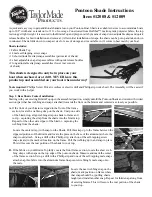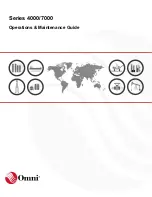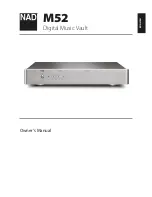
10
EN
M1.2.PTLK1-PTLK2.NLFREN 01102019
1 Safety information
General safety instructions
• Read and understand all instructions. Failure to follow all instructions may result in serious injury or property damage.
• The warnings, cautions, and instructions in this manual cannot cover all possible conditions or situations that could occur.
Exercise common sense and caution when using this tool. Always be aware of the environment and ensure that the tool is
used in a safe and responsible manner.
• Do not allow persons to operate or assemble the product until they have read this manual and have developed a thorough
understanding of how it works.
•
Do not modify this product in any way. Unauthorized modification may impair the function and/or safety and could affect
the life of the product. There are specific applications for which the product was designed.
• Use the right tool for the job. Do not attempt to force small equipment to do the work of larger industrial equipment. There
are certain applications for which this equipment was designed. This product will be safer and do a better job at the
capacity for which it was intended. Do not use this equipment for a purpose for which it was not intended.
• Industrial or commercial applications must follow OSHA requirements.
Work area safety
• Inspect the work area before each use. Keep work area clean, dry, free of clutter, and well-lit. Cluttered, wet, or dark work
areas can result in injury. Using the product in confined work areas may put you dangerously close to cutting tools and
rotating parts.
•
Do not use the product where there is a risk of causing a fire or an explosion, e.g., in the presence of flammable liquids,
gases, or dust. The product can create sparks, which may ignite the flammable liquids, gases, or dust.
• Keep children and bystanders away from the work area while operating the tool. Do not allow children to handle the
product.
• Be aware of all power lines, electrical circuits, water pipes, and other mechanical hazards in your work area. Some of
these hazards may be hidden from your view and may cause personal injury and/or property damage if contacted.
Personal safety
• Stay alert, watch what you are doing, and use common sense when operating the tool. Do not use the tool while you are
tired or under the influence of drugs, alcohol, or medication. A moment of inattention while operating the tool may result in
serious personal injury.
• Dress properly. Do not wear loose clothing, dangling objects, or jewellery. Keep your hair, clothing and gloves away from
moving parts. Loose clothes, jewellery, or long hair can be caught in moving parts. Air vents on the tool often cover moving
parts and should be avoided.
• Wear the proper personal protective equipment when necessary. Use ANSI Z87.1 compliant safety goggles (not safety
glasses) with side shields, or when needed, a face shield. Use a dust mask in dusty work conditions. Also use non-skid
safety shoes, hard hat, gloves, dust collection systems, and hearing protection when appropriate. This applies to all persons
in the work area.
• Do not overreach. Keep proper footing and balance at all times.
Crane use and care
• Do not force the crane. Products are safer and do a better job when used in the manner for which they are designed. Plan
your work, and use the correct product for the job.
• Check for damaged parts before each use. Carefully check that the product will operate properly and perform its intended
function. Replace damaged or worn parts immediately. Never operate the product with a damaged part.
• Store the product when it is not in use. Store it in a dry, secure place out of the reach of children. Inspect the tool for good
working condition prior to storage and before re-use.
• Use only accessories that are recommended by the manufacturer for use with your product. Accessories that may be
suitable for one product may create a risk of injury when used with another tool. Never use an accessory that has a lower
operating speed or operating pressure than the tool itself.
copyrighted
document
- all
rights
reserved
by
FBC


































